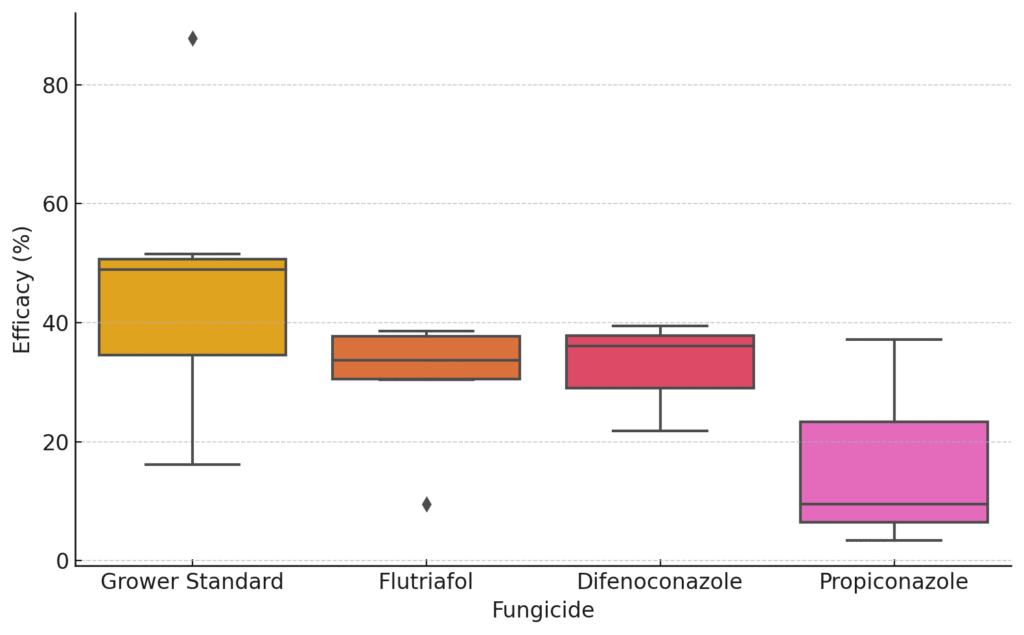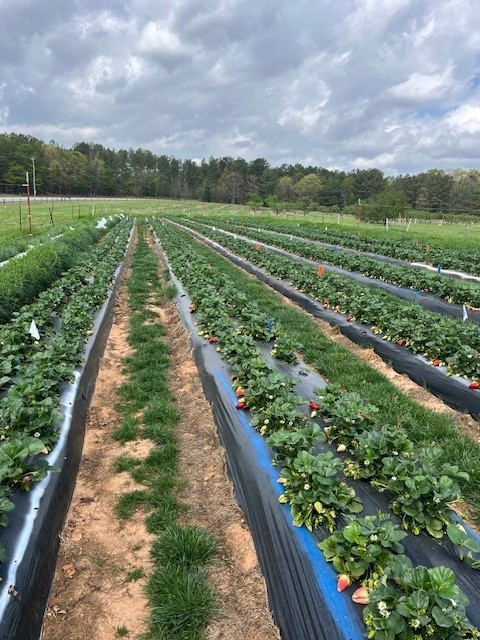Guido Schnabel and Johanna Wesche, Clemson University
Demethylation Inhibitor (DMI) fungicides have been around for a while. Propiconazole, for example, was first registered in 1981 and is still labelled and used today. New DMIs with greater intrinsic efficacy and more favorable toxicity profiles are still being developed. One such example is mefentrifluconazole (Cevya). DMIs belong to FRAC code 3 and are single-site fungicides, thus vulnerable to resistance development and should always be used in moderation and as part of a resistance management program. They play a key role in managing fungal diseases in fruit crops in the United States, particularly powdery mildew and anthracnose of strawberry; brown rot and leaf rust of peach; leaf rust, mummy berry, Phomopsis twig blight, and septoria leaf spot of blueberry; and cane diseases and rusts, powdery mildew, rosette, and leaf spots of blackberry.
DMIs registered for powdery mildew control of strawberries include flutriafol (Rhyme), difenoconazole (Inspire), mefentrifluconazole (Cevya), myclobutanil (Rally), tetraconazole (Mettle), and triflumizole (Procure). In South Carolina, we don’t use DMIs routinely because powdery mildew is typically not an issue in annual plasticulture outside tunnels. But the DMIs have enjoyed renewed interest among strawberry growers due to reported suppression of Neopestalotiopsis disease. In laboratory studies, difenoconazole (Inspire) and propiconazole (Tilt) inhibited Neopestalotiopsis mycelium, as indicated by EC50 values averaging 0.2 and 0.5 µg/ml, respectively; the value for flutriafol (Rhyme) was 8.4 µg/ml. Note, the lower the EC50 value, the more effective the fungicide in petri dish assays. DMIs also showed suppressive action against Neopestalotiopsis in field experiments. Results of field trials conducted between 2020 and 2024 showed that difenoconazole (applied as Inspire and Regev) and flutriafol (Rhyme) had the best suppressive action against Neopestalotiopsis fruit rot (Fig. 1). These products were applied either weekly by themselves or biweekly in rotation with Thiram (Baggio et al. 2023, Rebello et al. 2024, Gama et al. 2022, Rebello et al. 2023, Baggio et al. 2021). Surprisingly, the grower standards in those studies (typically Thiram and Switch rotations) were only marginally more effective. Despite the weaker lab performance, flutriafol (Rhyme) held its own and was as effective as difenoconazole (Inspire or Regev) although the active ingredient dose rates per acre were the same (Fig. 1). The take home message is that DMI fungicides are of value against Neopestalotiopsis disease. You may have noticed in Figure 1 that the average efficacy values were less than 50% for all treatments, including the grower standard. That just shows you how difficult it is to control Neopestalotiopsis with fungicides; there are no really good options.

But with the “good” comes the “ugly.” Some DMI fungicides may also act as growth regulators and stunt plants. For example, paclobutrazol (Bonzi) is used to control the growth of ornamental plants and trees. Your nursery contact will tell you that propiconazole WILL stunt the strawberry tips. Freeman et al. (1997) found that propiconazole caused mild phytotoxicity, including slight stunting and leaf scorching in treated strawberry plants. De los Santos and Romero (2002) also noted consistent phytotoxic effects in greenhouse and field trials. Treated plants exhibited abnormal growth, described as stunted with dark green leaves. In a more recent publication, six consecutive applications of Orbit, Quilt Xcel, and Inspire XT (all contained propiconazole) to ‘Camarosa’ plants for powdery mildew control revealed indirect evidence of plant injury; plants treated with propiconazole products yielded lower yields (Mertely et al. 2010).
This year, we did our own test at the Musser Fruit Research Center at Clemson University and assessed the impact of various DMI fungicide programs after planting on ‘Albion’ canopy height and total yield. Applications were conducted in 10 to 14-day intervals starting 7 days after planting the ‘Albion’ plugs and when plants started to resume growth in spring (Fig. 2). All treatments included Thiram either alone or in combination with a DMI fungicide—Propi-Star (propiconazole), Inspire (difenoconazole), or Rhyme (flutriafol)—applied once or three times during either fall or spring. Results showed that three consecutive fall applications of Thiram mixed with Propi-Star reduced canopy size, but not by much (Table 1). Measurements taken in early spring (April 9) showed that canopy height in spring did not differ significantly among treatments, and there were no significant differences in yield. Among spring-treated plants (they were not treated in the fall), a slightly smaller canopy size was again observed for the Thiram + Propi-Star treatment applied three times, but none of the treatments led to reduced yields (data not shown).



In conclusion, plants treated with DMI fungicides flutriafol (Rhyme) or difenoconazole (Inspire and Regev) up to three times in fall or in spring showed no negative effects on ‘Albion’ plants. Repeated applications of propiconazole (Propi-Star) did have some transient stunting effects and therefore this DMI should be used with caution (Wesche et al. 2025). DMI fungicides are vulnerable to resistance development and should not be used more than two or three times per production season (not per year).
Table 1. Influence of DMI fungicides applied once or three times after planting in the fall on canopy size and yield in ‘Albion’ strawberries.
| Treatment | Rate/A | Number of applications | Canopy diameter 22-Nov | Canopy diameter 9-Apr | Canopy height | Yield/plant* | Total yield (kg)* |
|---|---|---|---|---|---|---|---|
| Thiram | 2.5 qt | 1, 2, 3 | 9.15 ab | 12.36 ab | 8.26 a | 50.47 a | 1.51 |
| Thiram + Propi-Star (41.8% ai) | 2.5 qt + 4 fl oz | 1 | 9.64 a | 12.10 ab | 8.16 a | ||
| Thiram + Propi-Star (41.8% ai) | 2.5 qt + 4 fl oz | 1, 2, 3 | 8.77 b | 11.86 b | 7.99 a | 47.48 a | 1.42 |
| Thiram + Inspire (23.2% ai) | 2.5 qt + 7 fl oz | 1 | 9.54 ab | 12.02 ab | 8.28 a | ||
| Thiram + Inspire (23.2% ai) | 2.5 qt + 7 fl oz | 1, 2, 3 | 9.55 ab | 12.28 ab | 8.02 a | 57.12 a | 1.71 |
| Thiram + Rhyme (22.7% ai) | 2.5 qt + 7 fl oz | 1 | 9.54 ab | 12.14 ab | 7.97 a | ||
| Thiram + Rhyme (22.7% ai) | 2.5 qt + 7 fl oz | 1, 2, 3 | 9.40 ab | 12.49 a | 8.03 a | 51.11 a | 1.53 |
References
Freeman, S., Nizani, Y., Dotan, S., Even, S., & Sando, T. (1997). Control of Colletotrichum acutatum in strawberry under laboratory, greenhouse, and field conditions. Plant Dis. 81:749–752.
De los Santos García de Paredes, B., & Romero Muñoz, F. (2002). Effect of different fungicides in the control of Colletotrichum acutatum, causal agent of anthracnose crown rot in strawberry plants. Crop Prot. 21:11–15.
Mertely J., Seijo, T., Martin, R., Moor D.N., and Peres N.A. 2010. Evaluation of fungicides to control powdery mildew on annual strawberry, 2009-2010 (PDF). Plant Dis. Manag. Rep. 5:SMF017.
Gama, A. B., Baggio, J.S., and Peres, N.A. 2022. Evaluation of products for the control of Pestalotia leaf spot and fruit rot in annual strawberry, 2021-22 (PDF). Plant Dis. Manag. Rep. 16:PF060.
Rebello, C.S., and Peres, N.A. 2022. Evaluation of fungicide products to control Pestalotia fruit rot and leaf spot in annual strawberry, 2022-23 (PDF). Plant Dis. Manag. Rep. 17:PF044.
Baggio, J.S., Rebello, C.S., deMorais, M.B., Marin, M.V., Gama, A.B., Forcelini, B.B., Mertely, J., and Peres, N.A. 2023. Efficacy of single- and multi-site fungicides against Neopestalotiopsis spp. of strawberry. Plant Dis. 107:2177-2184.
Baggio, J.S., Bolognesi, M., and Peres, N.A. 2021. Evaluation of products for the control of Pestalotia fruit rot in annual strawberry, 2020-21 (PDF). Plant Dis. Manag. Rep. 15:PF048.
Rebello, C. S., Marin, M.V., and Peres, N.A. 2024. Evaluation of fungicide products to control Pestalotia fruit rot and leaf spot in annual strawberry, 2023-24 (PDF). Plant Dis. Manag. Rep. 18:PF053.
Wesche, J., Gelain J., Hopkins, J.A., Schnabel, G. 2025. Effect of DMI fungicides on plant growth and yield in annual strawberries in South Carolina. Plant Health Progress, in press.